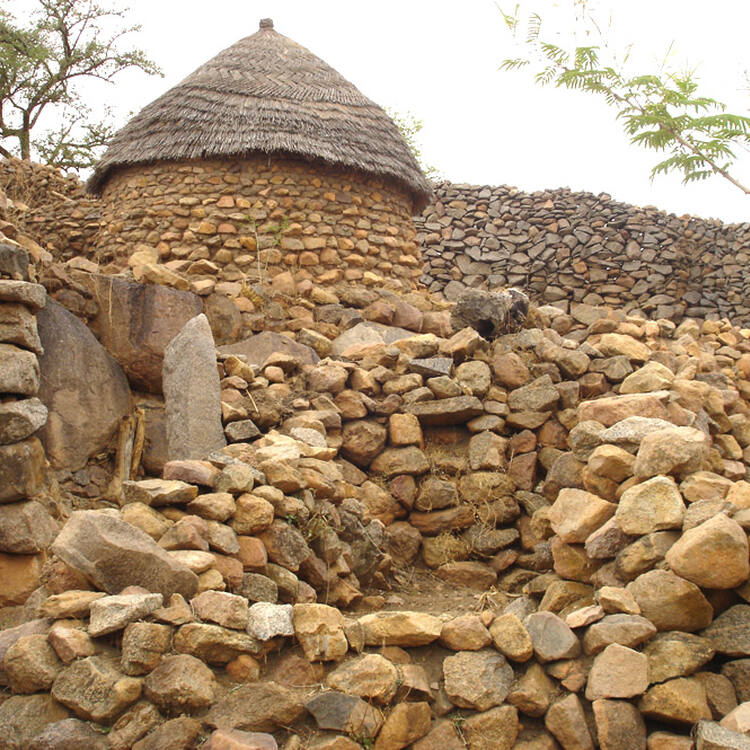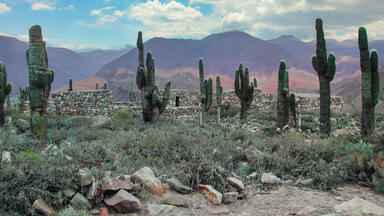Sukur Cultural Landscape
Sukur Cultural Landscape
The Sukur Cultural Landscape, with the Palace of the Hidi (Chief) on a hill dominating the villages below, the terraced fields and their sacred symbols, and the extensive remains of a former flourishing iron industry, is a remarkably intact physical expression of a society and its spiritual and material culture.
Description is available under license CC-BY-SA IGO 3.0
Paysage culturel de Sukur
Le paysage culturel de Sukur – avec le palais du Hidi (chef) sur une colline dominant les villages en contrebas, ses champs en terrasses et leurs symboles sacrés, ainsi que les vestiges omniprésents de l'ancienne industrie florissante du fer – reflète fidèlement la société qui l'a créé il y a des siècles et sa culture spirituelle et matérielle.
Description is available under license CC-BY-SA IGO 3.0
منظر سوكور الثقافي
تعكس طبيعة سوكور الثقافية مع قصر هيدي (القائد) الذي يقع على تلة تطلّ على القرى في الاسفل، ومع حقولها المسطحة ورموزها المقدسة بالاضافة الى الآثار الموجودة في كل مكان لصناعة الحديد القديمة المزدهرة، المجتمع الذي أنشأها منذ قرون عديدة بامتياز وبثقافته الروحية والمادية.
source: UNESCO/CPE
Description is available under license CC-BY-SA IGO 3.0
宿库卢文化景观
苏库尔文化景观包括建在小山上俯瞰下方村庄的酋长宫殿、平坦的场地和神圣的图腾,以及曾经繁荣的铁器工业的大量遗迹。这一景观完整地体现了社会原貌,反映了它的精神文明和物质文明。
source: UNESCO/CPE
Description is available under license CC-BY-SA IGO 3.0
Культурный ландшафт Сукур
Культурный ландшафт Сукур включает находящийся на холме дворец хиди (вождя), доминирующий над нижерасположенными селениями, террасированные поля, священные символы, а также многочисленные следы преуспевающего в прошлом железоделательного производства. Все это яркие свидетельства духовной и материальной культуры местного сообщества.
source: UNESCO/CPE
Description is available under license CC-BY-SA IGO 3.0
Paisaje cultural de Sukur
El palacio del hidi (jefe) erigido en posición dominante en lo alto de una colina, las aldeas circundantes, los cultivos en terrazas y sus símbolos sagrados, y los vestigios omnipresentes de la floreciente actividad siderúrgica de antaño componen este paisaje cultural, que es la viva expresión intacta de la cultura material y espiritual de la sociedad que lo creó siglos atrás.
source: UNESCO/CPE
Description is available under license CC-BY-SA IGO 3.0
スクルの文化的景観
ナイジェリアの南東部、アマダワ高原地帯。眼下の集落を統治する丘陵上の支配者の宮殿、段々畑の広がり、幾多の聖なる象徴、かつて反映した製鉄業の広大な遺跡。前期鉄器時代と17世紀以後、20世紀初期まで盛んであった、ありし日の姿を物語るスクルのこのような景観は、一つの社会とその精神的・物質的文化の表象である。この文化の解明は、モザンビーク、ジンバブエ、ケニアの同様な文化の理解にも連動しよう。写真は神殿にある頭部彫像。source: NFUAJ
Cultuurlandschap van Sukur
Het cultuurlandschap van Sukur bevat het Paleis van de Hidi (Opperhoofd), dat van grote politieke en religieuze betekenis is voor de bevolking van Sukur. Het paleis ligt op een heuvel en domineert de dorpen die zich daaronder bevinden. Naast het paleis herbergt Sukur terrasvormige velden en hun heilige symbolen en de uitgebreide overblijfselen van een voormalig bloeiende ijzerindustrie. Het cultuurlandschap is een opmerkelijk intact gebleven uiting van een samenleving en haar geestelijke en materiële cultuur. Sukur is gedurende vele eeuwen ongewijzigd gebleven. Daarmee is het een bewijs van een sterke culturele traditie die vele eeuwen heeft doorstaan.
Source: unesco.nl
Outstanding Universal Value
Brief synthesis
Sukur is located in Madagali local government area of Adamawa state of Nigeria along Nigeria/ Cameroon border, some 290 km from Yola, the Adamawa state capital of north eastern Nigeria. It is a hilltop settlement which stood at an elevation of 1045 m. The total land area covered by the site is 1942.50 ha with core zone having 764.40 ha and the buffer zone 1178.10 ha respectively. Sukur is an ancient settlement with a recorded history of iron smelting technology, flourishing trade, and strong political institution dating back to the 16th century.
The landscape is characterized by terraces on the farmlands, dry stone structures and stone paved walkways.The terraced landscape at Sukur with its hierarchical structure and combination of intensive and extensive farming is remarkable. In addition, it has certain exceptional features that are not to be found elsewhere, notably the use of paved tracks and the spiritual content of the terraces, with their ritual features such as sacred trees.
The revered position of the Hidi as the political and spiritual head of the community is underscored by the magnificent dry stone architectural work of his palace, in and around which is a concentration of shrines, some ceramic. The villages situated on low lying ground below the Hidi Palace have their own characteristic indigenous architecture. Among its features are dry stone walls, used as social markers and defensive enclosures, sunken animal (principally bull) pens, granaries, and threshing floors. Groups of mud walled thatched roofed houses are integrated by low stone walls. Of considerable social and economic importance are the wells. These are below-ground structures surmounted by conical stone structures and surrounded by an enclosure wall. Within the compound are pens where domestic animals such as cattle and sheep are fattened, either for consumption by the family or for use as prestige and status symbols used in gift and marriage exchanges.
The remains of many disused iron-smelting furnacescan still be found. These shaft-type furnaces, blown with bellows, were usually sited close to the houses of their owners. Iron production involved complex socio-economic relationships and there was a considerable ritual associated with it.
Criterion (iii): Sukur is an exceptional landscape that graphically illustrates a form of land-use that marks a critical stage in human settlement and its relationship with its environment.
Criterion (v): The cultural landscape of Sukur has survived unchanged for many centuries, and continues to do so at a period when this form of traditional human settlement is under threat in many parts of the world.
Criterion (vi): The cultural landscape of Sukur is eloquent testimony to a strong and continuing spiritual and cultural tradition that has endured for many centuries.
Integrity
The boundary contains all the key elements of the cultural landscape.
The traditional terraced system of agriculture and its associated ritual systems are still flourishing. However, the traditional buildings are vulnerable to changes in materials and techniques – particularly the thatched roofs that require frequent maintenance.
Authenticity
The key features of the cultural landscape have not been significantly modified since they were laid down. The way in which they have been maintained since that time has been in traditional form using traditional materials and techniques.
The cultural components are still actively present among the community since they are part of their living culture. The stone structures in form of houses, farm terraces and walkways still remain the most distinct feature of Sukur landscape. The regular observance of festivals and ceremonies are evidence of cultural continuity. These events have become more attractive due to the involvement of local and state governments.
Protection and management requirements
The Sukur Cultural Landscape is a National Monument as determined by the Joint Instrument of Federal Decree No. 77 of 1979 (now NCMM ACT, Cap 242 of 2000) and the subsequent legal authority of the Adamawa State Government as in Gazette No. 47 Vol. 7 of 20 November 1997, and the written consent of the Hidi-in-Council.
In 1998, the Madagali Local Government, the Sukur Development Association, the State Council for Arts and Culture, and Adamawa State Government have agreed to work with the National Commission for Museums and Monuments towards the development of a sustainable preservation and cultural education programme.
In February 2010, the Minister of Culture, Tourism and National Orientation inaugurated a Management Committee. Integrating customary law and Nigeria’s decree No. 77 of 1979, the Site Management Plan for the period 2006-2011 is being used by the Committee as the guiding principle for site conservation, management and protection.
Since inscription in 1999, all physical remains have been properly conserved by the National Commission for Museums and Monuments in collaboration with Sukur community. Annual restoration work has been carried out using traditional construction materials. Along with shrines and other sacred places, the Hidi Palace Complex is properly maintained because they are currently in use.
Domestic farmlands are continually being expanded with the creation of stepped level benches adapted to hill farming. The age long tradition of communal labour is still used to maintain paved walkways, gates, graveyards, homesteads and house compounds.



